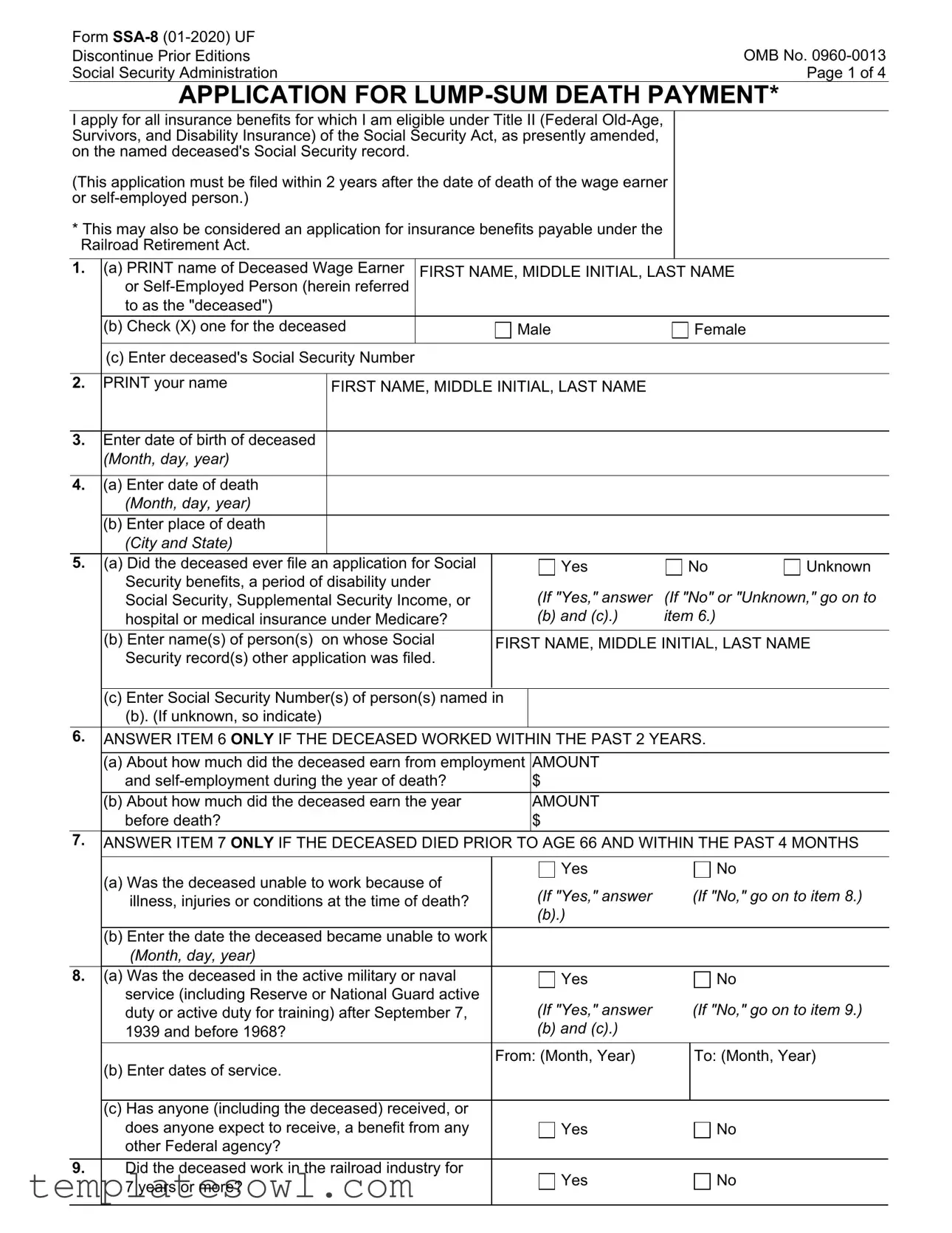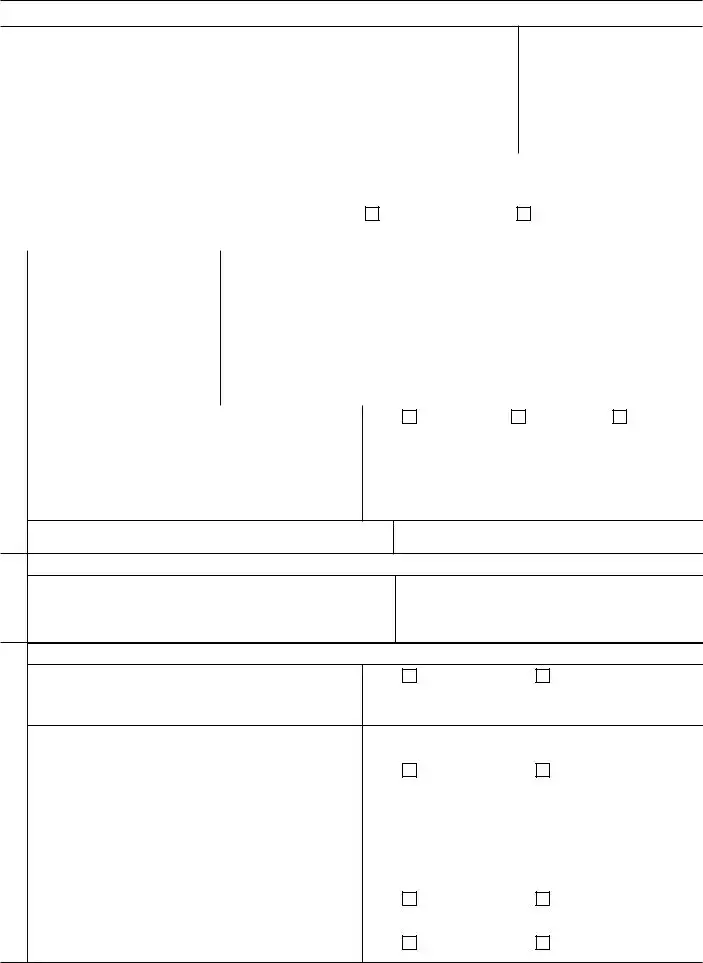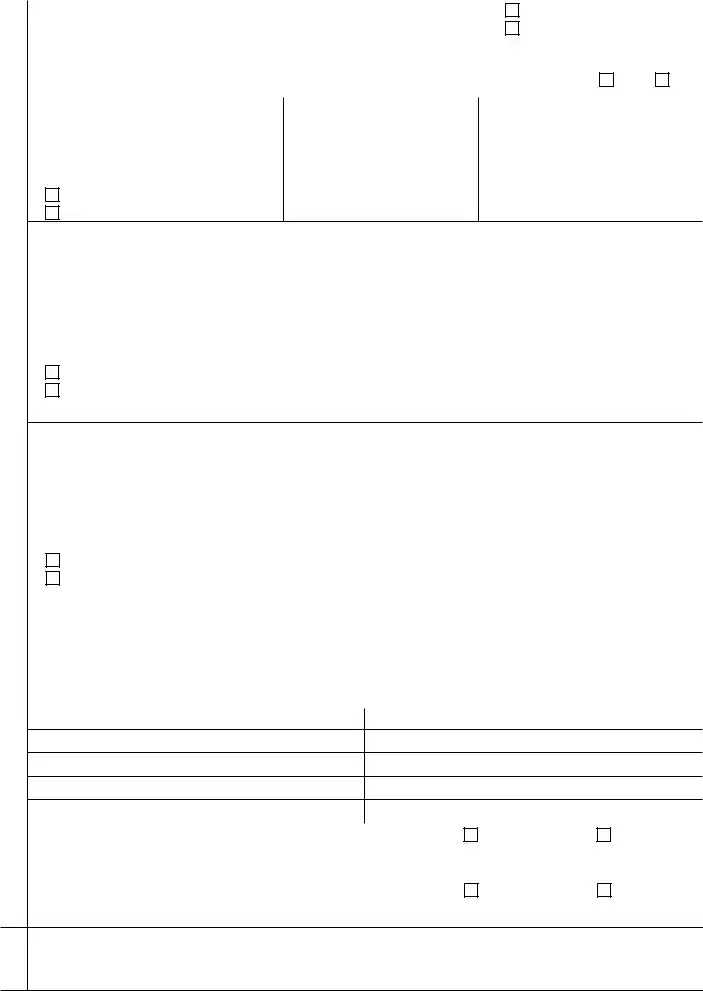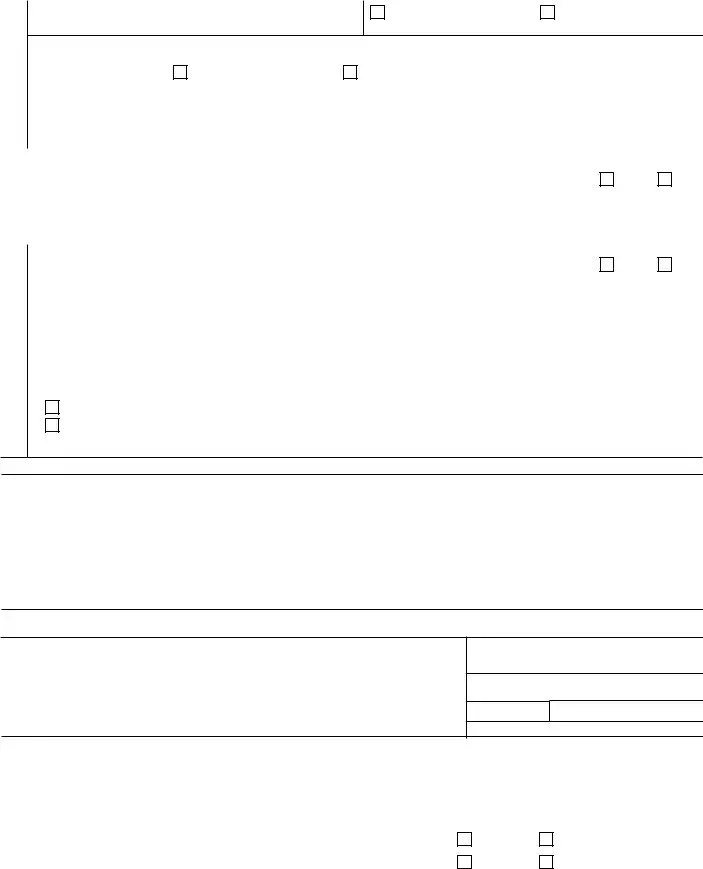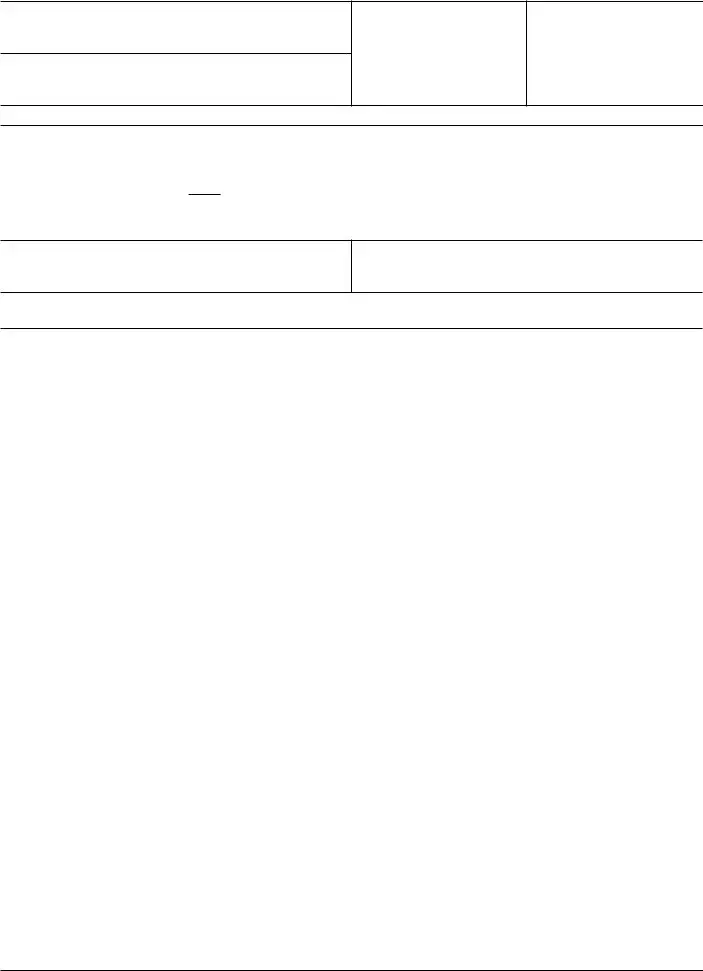Form SSA-8 (01-2020) UF |
OMB No. 0960-0013 |
Discontinue Prior Editions |
Social Security Administration |
Page 1 of 4 |
APPLICATION FOR LUMP-SUM DEATH PAYMENT*
I apply for all insurance benefits for which I am eligible under Title II (Federal Old-Age, Survivors, and Disability Insurance) of the Social Security Act, as presently amended, on the named deceased's Social Security record.
(This application must be filed within 2 years after the date of death of the wage earner or self-employed person.)
*This may also be considered an application for insurance benefits payable under the Railroad Retirement Act.
1. |
(a) PRINT name of Deceased Wage Earner |
FIRST NAME, MIDDLE INITIAL, LAST NAME |
|
|
or Self-Employed Person (herein referred |
|
|
|
|
to as the "deceased") |
|
|
|
|
|
(b) Check (X) one for the deceased |
Male |
Female |
|
|
|
|
|
|
|
(c) Enter deceased's Social Security Number |
|
|
|
|
|
|
|
|
2. |
PRINT your name |
FIRST NAME, MIDDLE INITIAL, LAST NAME |
|
3. |
Enter date of birth of deceased |
|
|
|
|
(Month, day, year) |
|
|
|
|
|
|
|
|
4. |
(a) Enter date of death |
|
|
|
|
(Month, day, year) |
|
|
|
|
(b) Enter place of death |
|
|
|
|
(City and State) |
|
|
|
5. |
(a) Did the deceased ever file an application for Social |
Yes |
No |
Unknown |
|
Security benefits, a period of disability under |
(If "Yes," answer |
(If "No" or "Unknown," go on to |
|
Social Security, Supplemental Security Income, or |
|
hospital or medical insurance under Medicare? |
(b) and (c).) |
item 6.) |
|
|
(b) Enter name(s) of person(s) on whose Social |
FIRST NAME, MIDDLE INITIAL, LAST NAME |
|
Security record(s) other application was filed. |
|
|
|
(c)Enter Social Security Number(s) of person(s) named in
(b). (If unknown, so indicate)
6.ANSWER ITEM 6 ONLY IF THE DECEASED WORKED WITHIN THE PAST 2 YEARS.
(a)About how much did the deceased earn from employment AMOUNT
and self-employment during the year of death? |
$ |
(b) About how much did the deceased earn the year |
AMOUNT |
before death? |
$ |
7.ANSWER ITEM 7 ONLY IF THE DECEASED DIED PRIOR TO AGE 66 AND WITHIN THE PAST 4 MONTHS
|
(a) Was the deceased unable to work because of |
Yes |
No |
|
(If "Yes," answer |
(If "No," go on to item 8.) |
|
illness, injuries or conditions at the time of death? |
|
|
(b).) |
|
(b)Enter the date the deceased became unable to work (Month, day, year)
8. |
(a) Was the deceased in the active military or naval |
Yes |
No |
|
service (including Reserve or National Guard active |
(If "Yes," answer |
(If "No," go on to item 9.) |
|
duty or active duty for training) after September 7, |
|
1939 and before 1968? |
(b) and (c).) |
|
|
(b) Enter dates of service. |
From: (Month, Year) |
To: (Month, Year) |
|
|
|
|
|
|
|
|
(c) Has anyone (including the deceased) received, or |
|
|
|
does anyone expect to receive, a benefit from any |
Yes |
No |
|
other Federal agency? |
|
|
9. |
Did the deceased work in the railroad industry for |
Yes |
No |
|
7 years or more? |
|
|
|
|
Form SSA-8 (01-2020) UF |
|
|
|
|
Page 2 of 4 |
|
10. (a) Did the deceased ever engage in work that was covered under the social |
|
Yes |
(If "Yes," answer (b).) |
|
|
security system of a country other than the United States? |
|
No (If "No," go on to item 11.) |
|
|
|
|
|
|
|
|
(b) If "Yes," list the country(ies). |
|
|
|
|
|
|
|
|
11. |
(a) Is the deceased survived by a |
spouse? |
|
|
|
|
Yes |
No |
|
|
If "Yes," enter information about the marriage at the time of death below. If "No," go on to |
|
|
|
item 11(b) if the deceased had prior marriages or item 12 if the deceased never married. |
|
|
|
|
|
Spouse's Name (including Maiden Name) |
When (Month, day, year) |
Where (Name of City and State) |
|
|
|
|
|
|
|
|
|
How marriage ended |
When (Month, day, year) |
Where (Name of City and State) |
|
|
|
|
|
|
|
|
Marriage performed by: |
Spouse's date of birth (or age) |
Spouse's Social Security Number (If |
|
|
Clergyman or public official |
none or unknown, so indicate) |
|
|
|
|
|
|
|
Other (Explain in "Remarks") |
|
|
|
|
|
|
(b)If the deceased had a prior marriage(s) that lasted at least 10 years, enter the information below. If the deceased married the same individual multiple times and the remarriage took place within the year immediately following the year of the divorce, and the combined period of marriage totaled 10 years or more, include the marriage. If no prior marriages or if information is unavailable, please indicate below.
|
Spouse's Name (including Maiden Name) |
When (Month, day, year) |
Where (Name of City and State) |
|
|
|
|
|
How marriage ended |
When (Month, day, year) |
Where (Name of City and State) |
|
|
|
|
|
Marriage performed by: |
Spouse's date of birth (or age) |
If spouse deceased, give date |
|
Clergyman or public official |
of death |
|
|
|
Other (Explain in "Remarks") |
|
|
|
Spouse's Social Security Number (If none or unknown, so indicate) |
|
(c)If the deceased has a surviving child(ren) as defined in item 12 and the deceased was married to the child's mother or father but the marriage ended in divorce, enter information on the marriage if not already listed in 11(b). If no prior marriages or if information is unavailable, please indicate below.
|
Spouse's Name (including Maiden Name) |
When (Month, day, year) |
Where (Name of City and State) |
|
|
|
|
|
How marriage ended |
When (Month, day, year) |
Where (Name of City and State) |
|
|
|
|
|
Marriage performed by: |
Spouse's date of birth (or age) |
If spouse deceased, give date |
|
Clergyman or public official |
of death |
|
|
|
Other (Explain in "Remarks") |
|
|
|
Spouse's Social Security Number (If none or unknown, so indicate) |
|
|
|
|
|
12. |
The deceased's surviving children (including natural children, adopted children, and stepchildren) or dependent |
|
grandchildren (including stepgrandchildren) may be eligible for benefits based on the earnings record of the deceased. |
|
List below ALL such children who are now or were in the past 12 months UNMARRIED and: |
|
• UNDER AGE 18 • AGE 18 TO 19 AND ATTENDING SECONDARY SCHOOL |
|
• AGE 18 OR OLDER WITH A DISABILITY THAT BEGAN BEFORE AGE 22 |
|
(If none, write ''None.'') |
|
|
|
|
|
|
|
Full Name of Child |
|
Full Name of Child |
13. |
Is there a surviving parent (or parents) of the deceased who |
Yes |
No |
|
was receiving support from the deceased either at the time |
(If "Yes," enter the name and |
|
|
the deceased became disabled under the Social Security law |
|
|
or at the time of death? |
address of the parent(s) in "Remarks".) |
14. |
Have you filed for any Social Security benefits on the |
Yes |
No |
|
deceased's earnings record before? |
|
|
|
NOTE: If there is a surviving spouse, continue with item 15. If not, skip items 15 through 18.
15.If you are not the surviving spouse, enter the surviving spouse's name and address here
Form SSA-8 (01-2020) UF |
|
Page 3 of 4 |
16. |
(a) Were the deceased and the surviving spouse living |
Yes |
No |
|
together at the same address when the deceased died? |
(If "Yes," go on to item 17.) |
(If "No," answer (b).) |
(b)If either the deceased or surviving spouse was away from home (whether or not temporarily) when the deceased died, give the following:
|
Who was away? |
|
Deceased |
|
Surviving spouse |
|
|
|
|
|
Date last home |
Reason absence began |
|
Reason they were apart at time of death |
|
|
|
|
|
|
|
|
|
|
|
|
If separated because of illness, enter |
|
|
|
|
|
|
|
|
nature of illness or disabling condition. |
|
|
|
|
|
|
|
If you are the surviving spouse, and if you are under age 66, answer 17. |
|
|
|
|
17. |
(a) Are you so disabled that you cannot work or was there some period during the last 14 |
|
Yes |
No |
|
months when you were so disabled that you could not work? |
|
|
|
|
|
|
|
|
(b) If ''Yes,'' enter the date you became disabled. |
|
|
|
(Month, day, year) |
|
|
|
|
|
|
|
|
|
Answer 18 ONLY if you are the surviving spouse. |
|
|
|
|
|
|
18. Were you married before your marriage to the deceased? If yes, enter information about your |
|
Yes |
No |
|
prior marriage(s) that lasted at least 10 years or ended due to death of the spouse. If you |
|
|
divorced then remarried the same individual within the year immediately following the year of |
|
|
|
|
the divorce and the combined period of marriage totaled at least 10 years, include the marriage. |
|
|
|
If you need more space, use "Remarks" section on back page or attach a separate sheet. |
|
|
|
|
Spouse's Name (including Maiden Name) |
When (Month, day, year) |
Where (Name of City and State) |
|
|
|
|
|
|
|
|
How marriage ended |
|
When (Month, day, year) |
Where (Name of City and State) |
|
|
|
|
|
|
|
|
|
|
Marriage performed by: |
|
Spouse's date of birth (or age) |
If spouse deceased, give date |
|
|
Clergyman or public official |
of death |
|
|
|
|
|
|
|
|
|
|
|
Other (Explain in "Remarks") |
|
|
|
|
|
|
|
Spouse's Social Security Number (If none or unknown, so indicate)
For additional information about survivor benefits see our publication at www.socialsecurity.gov.
Remarks: (You may use this space for any explanation. If you need more space, attach a separate sheet.)
I declare under penalty of perjury that I have examined all the information on this form, and on any accompanying statements or forms, and it is true and correct to the best of my knowledge.
SIGNATURE OF APPLICANTDate (Month, day, year)
Signature (First name, middle initial, last name) (Write in ink)
Telephone Number(s) at Which You
May Be Contacted During the Day
(Area Code)
Mailing Address (Number and street, Apt. No., P.O. Box, or Rural Route)
City and State |
|
ZIP Code |
Enter Name of County (if any) in which you now live |
|
|
|
|
|
|
|
|
Direct Deposit Payment Information (Financial Institution) |
|
|
|
|
Routing Transit Number |
Account Number |
|
Checking |
|
Enroll in Direct Express |
|
|
|
|
|
Savings |
|
Direct Deposit Refused |
|
|
|
|
|
Witnesses are required ONLY if this application has been signed by mark (X) above. If signed by mark (X), two |
witnesses to the signing who know the applicant must sign below, giving their full addresses. |
|
1. Signature of Witness |
|
|
|
2. Signature of Witness |
|
|
|
Address (Number and street, City, State, and ZIP Code) |
Address (Number and street, City, State, and ZIP Code) |
|
|
|
|
|
|
|
|
Form SSA-8 (01-2020) UF |
Page 4 of 4 |
RECEIPT FOR YOUR CLAIM FOR THE SOCIAL SECURITY LUMP-SUM DEATH PAYMENT |
|
TELEPHONE NUMBER TO CALL IF YOU HAVE A QUESTION OR SOMETHING TO REPORT
TELEPHONE NUMBER
Your application for the lump-sum death payment has been received and will be processed as quickly as possible.
You should hear from us within days after you have given us all the information we requested. Some claims may take longer if additional information is needed.
In the meantime, if you change your mailing address, you should report the change.
Always give us your claim number when writing or telephoning about your claim.
If you have any questions about your claim, we will be glad to help you.
SOCIAL SECURITY CLAIM NUMBER
DECEASED'S NAME (If surname differs from claimant's name)
Privacy Act Statement - Application for Lump-Sum Death Payment
Collection and Use of Personal Information
Section 202 of the Social Security Act, as amended, allows us to collect this information. Furnishing us this information is voluntary. However, failing to provide all or part of the information may prevent us from making an accurate and timely determination on any claim filed and could result in a loss of a Social Security Administration (SSA) provided benefit.
We will use the information to authorize our one-time disbursement of the lump-sum death payment to a widow, widower, or children as defined in Section 202. We may also share your information for the following purposes, called routine uses:
•Information may be disclosed to contractors and other Federal agencies, as necessary, for the purpose of assisting the SSA in the efficient administration of its programs. We contemplate disclosing information under this routine use only in situations in which SSA may enter a contractual or similar agreement with a third party to assist in accomplishing an agency function relating to this system of records; and
•To a congressional office in response to an inquiry from that office made at the request of the subject of a record.
In addition, we may share this information in accordance with the Privacy Act and other Federal laws. For example, where authorized, we may use and disclose this information in computer matching programs, in which our records are compared with other records to establish or verify a person’s eligibility for Federal benefit programs and for repayment of incorrect or delinquent debts under these programs.
A list of additional routine uses is available in our Privacy Act System of Records Notice (SORN) 60-0089, entitled Claims Folders Systems, as published in the Federal Register (FR) on April 1, 2003, at 68 FR 15784. Additional information, and a full listing of all of our SORNs, is available on our website at www.ssa.gov/privacy.
Paperwork Reduction Act Statement - This information collection meets the requirements of 44 U.S.C. § 3507, as amended by section 2 of the Paperwork Reduction Act of 1995. You do not need to answer these questions unless we display a valid Office of Management and Budget (OMB) control number. We estimate that it will take about 10 minutes to read the instructions, gather the facts, and answer the questions. Send only comments relating to our time estimate above to: SSA, 6401 Security Blvd, Baltimore, MD 21235-6401.
